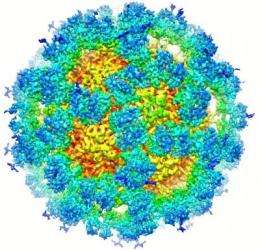Discovery offers insight into treating viral stomach flu

Twenty million Americans get sick from norovirus each year according to data released last week by the Centers for Disease Control (CDC). Often called vomiting illness, it can spread rapidly on cruise ships, and in dormitories and hospitals. Recent data from the CDC shows deaths from gastrointestinal infections have more than doubled and have become a particular threat to the elderly. The virus is shed in the stool of the infected individual, has a short incubation period and can spread quickly if proper hand washing and other measures are neglected.
While researchers say that vaccines for intestinal infections are among the most difficult to develop, a recent discovery may provide the critical information needed for success. "Sometimes atomic structure gives us clues on how viruses work and how to make better vaccines," said Dr. Thomas Smith, principal investigator, at The Donald Danforth Plant Science Center whose recent article, Structural Basis for Broad Detection of Genogroup II Noroviruses by a Monoclonal Antibody That Binds to a Site Occluded in the Viral Particle, in the Journal of Virology was selected by the editors as an, "Article of Significant Interest, sighting the extreme norovirus flexibility suggested by these results may allow for broad antibody recognition, a finding of potential vaccine significance."
Smith was part of a team of scientists lead by Dr. Peter D. Kwong, National Institute of Allergy and Infectious Diseases, National Institutes of Health (NIH). Their research demonstrated that the virus has a structure unlike that of other viruses in that is has protein "lollipop" like structures that likely gives it more flexibility in attaching to cells. There are four genera of this virus family, the Caliciviruses, with the Sapoviruses and Noroviruses being the major cause of severe gastroenteritis in humans.
Dr. Smith and his colleagues discovered that because of the "lollipop" structure, antibodies against the norovirus may be able to bind to the more conserved underside of this floppy structure. This suggests that the extreme flexibility of the norovirus particle may allow for antibody recognition of protected surfaces that might otherwise be buried on intact particles.
This information will give researchers more insight on how to manipulate complex viruses as well as to design and develop better drugs to treat the maladies they cause. Rotovirus, a member of a different viral family but also causes severe gastro intestinal distress primarily in children, is being well controlled by the recent development of a vaccine.















